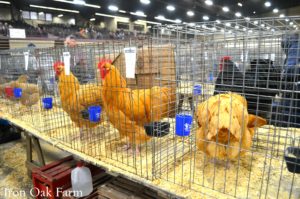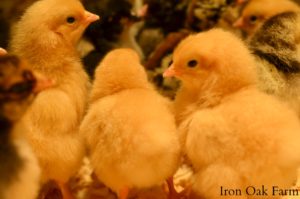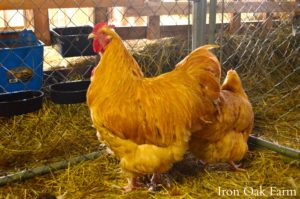 I remember the first time I saw a Buff Orpington chicken. It was at the State Fair and the bird was MASSIVE! It was in a large display cage and took up most of the space allotted. I fell in love immediately and vowed that one day I would raise these giant chickens.
I remember the first time I saw a Buff Orpington chicken. It was at the State Fair and the bird was MASSIVE! It was in a large display cage and took up most of the space allotted. I fell in love immediately and vowed that one day I would raise these giant chickens.
Fast forward a few years, in the springtime. I was at the local feed store making a beeline to the brooder boxes, as I had got a notification that the baby chicks had arrived. I followed the sound of peeping and saw the electric red glow of the heat lamps. Let’s roll up our sleeves folks and start filling boxes with chicks to take home.
I made the loop observing each breed…Rhode Island Red…check, Brahma…check, Cornish Cross…check, Buff Orpington…hold the phone!
 Buff Orpington!!! These were the giant chickens from the show! The beautiful Golden Retriever chickens that I fell in love with! Where’s a box? I need a box and some woodchips!
Buff Orpington!!! These were the giant chickens from the show! The beautiful Golden Retriever chickens that I fell in love with! Where’s a box? I need a box and some woodchips!
I immediately filled a small cardboard box with 6 chicks. I had hit pay dirt! These golden lovelies were going to be amazing!
Fast forward a year.
My giant chickens ended up being…not so giant. In fact, they were the same size as our Rhode Island Reds, and our Wyandottes.
Was it the feed? Was it just a runt hatch?
 The next spring I tried again. This time I raised them on meat bird feed. I thought that maybe larger chickens needed to be fed a more protein-rich food.
The next spring I tried again. This time I raised them on meat bird feed. I thought that maybe larger chickens needed to be fed a more protein-rich food.
These birds ended up being admittedly stockier, but the overall size was not much different than the rest of our flock.
What was I missing?
Over the years, talking to breeders, visiting shows, and raising hatchery chickens, I’ve learned that there is a big difference between a hatchery breed (which is what most of the feed stores get in each spring) and a farm-raised heritage breed.
There is such a difference between our heritage Buff Orpingtons and the hatchery birds that we have in our flock, that I almost feel like they’re two different breeds.

Front: Heritage Buff Orpington
Rear: Hatchery Buff Orpington
Not only are the heritage birds larger, but their feather structure, personality, and body shape are different.
This article is not to prove that one type of chicken is better than the other, only that hatchery-raised chickens serve a different purpose than farm-raised heritage breeds and hopefully, I can spare you the years it took e to figure out why my chickens looked different than those at the shows.
Pros of Hatchery Birds
 Quantity. Hatchery birds are likely the birds you will find at your local feed store. Hatcheries concentrate on offering a wide selection of chicken breeds in high numbers. You can order 100 mixed layers at once if you want.
Quantity. Hatchery birds are likely the birds you will find at your local feed store. Hatcheries concentrate on offering a wide selection of chicken breeds in high numbers. You can order 100 mixed layers at once if you want.
Cost. A quality, farm-raised heritage breed will cost around 10 times that of a hatchery bird. If you are a casual backyard chicken keeper, there is no reason to spend the additional amount that farm-raised chickens bring. Hatchery chickens lay the same amount of eggs as breeder chickens.
Availability. Hatchery birds are really easy to find. If you can’t find what you are looking for at your local feed store, you can place an online order and have your chicks delivered to your house.
Heritage birds can be difficult to locate. More than likely you will have to attend a show (we traveled 5 hours to Ohio to get our birds) or you will have to have birds or hatching eggs shipped.
You can choose the sex. Often hatchery chicks are sexed so you have a good chance of getting a hen. This is important to people who live in more urban settings and aren’t allowed a rooster. They’re perfect for the average family who just wants chickens as pets or egg layers.
Pros of Farm-Raised Heritage Breeds

 Quality. Breeders spend countless hours and breed generation upon generation trying to perfect the breed. When we talk about proliferating a heritage breed because the numbers are dwindling, these are the birds we’re talking about. These birds more closely represent what the actually breed according to the standard of perfection is supposed to look like.
Quality. Breeders spend countless hours and breed generation upon generation trying to perfect the breed. When we talk about proliferating a heritage breed because the numbers are dwindling, these are the birds we’re talking about. These birds more closely represent what the actually breed according to the standard of perfection is supposed to look like.
Offspring bring a good price. You can make a small business of selling quality chickens.
You can take these chickens to show. Well, technically you can take any chicken to show, but heritage chickens represent generations of selective breeding. If you’re interested in showing chickens you will have to get in touch with a quality breeder if you want a chance at winning the blue ribbon.
You can use quality stock to work on a breeding program to help increase numbers of rare or endangered breeds.













1 Comment
Awesome article as always!!